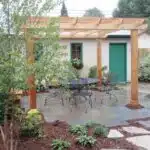As a professional carpenter, I have seen firsthand the impact that an awning can have on a home’s exterior. Not only does it provide protection from the elements, but it also adds a touch of sophistication and style to any property. However, purchasing and installing an awning can be costly and time-consuming. That’s why I’m here to show you how to build your own DIY wood awning.
Building your own wood awning is a rewarding project that can save you money while also allowing you to customize the design to fit your specific needs and preferences. With the right tools, materials, and techniques, building a wood awning can be a relatively simple process that even novice builders can accomplish. In this article, I will guide you through the step-by-step process of building a DIY wood awning for your home or business.
Tools And Materials Needed For The Project
Building a DIY wood awning requires the right tools and materials to ensure a successful outcome. It is like baking a cake, where the ingredients need to be carefully measured and mixed to achieve the desired taste. Choosing the right wood for your awning is essential as it will determine how long it will last and how well it will look. Cedar and redwood are popular choices as they are durable, weather-resistant, and aesthetically pleasing. Pine is another option, but it needs to be treated or painted regularly to prevent rotting.
Hardware such as screws, nails, brackets, and bolts are vital components of any wood awning project. Stainless steel or galvanized hardware is recommended as it resists corrosion and rusting. The type of hardware you choose depends on the design of your awning and the load-bearing capacity of your chosen wood. Before purchasing any materials, make sure you have a detailed plan of your project to avoid overspending on unnecessary items.
Tips for staying within budget include researching prices from different suppliers, buying in bulk if possible, and repurposing old materials if applicable. Consider using reclaimed wood from pallets or old furniture for an eco-friendly approach that also saves money. Always keep safety in mind when working with power tools and handling large pieces of wood. Wear protective gear such as gloves, goggles, and earplugs to prevent injuries while constructing your DIY wood awning.
To begin building your DIY wood awning, start by measuring and planning the design according to your desired dimensions. This involves determining the size of your lumber pieces based on the length and width of your awning frame. Stay tuned for the next section where we will discuss more about measuring and planning the awning design in detail.
Measuring And Planning The Awning Design
The first step in building a DIY wood awning is measuring and planning the design. Proper awning placement is critical to ensure it provides the desired amount of shade and protection from the elements. Take into consideration the direction of the sun, as well as any obstructions that could affect the placement of your awning.
Once you have determined the ideal location for your awning, it’s time to consider design customization. Are you looking for a traditional or modern look? How will the awning complement your home’s existing architecture? Consider factors such as color, materials, and shape when customizing your design.
To ensure accuracy in your measurements, use a level and measuring tape to determine the height, width, and length of the area where you plan to install your awning. It’s important to take precise measurements so that you can create a blueprint that accurately reflects your design vision.
Incorporate these tips to help guide you through measuring and planning your DIY wood awning:
- Use graph paper or an online sketch tool to map out your design plans.
- Consider adding decorative elements such as scalloped edges or trim for added visual appeal.
- Take into account any potential weather hazards such as high winds or heavy snow when designing and placing your awning.
Next up: creating a blueprint for the awning.
Creating A Blueprint For The Awning
As the old saying goes, failing to plan is planning to fail. When it comes to building a DIY wood awning, this couldn’t be more true. Before you even pick up your tools, you need to take the time to create a blueprint for your project. This will save you time and money in the long run and ensure that your awning turns out exactly as you envision it.
Planning tips are essential when creating a blueprint for your DIY wood awning. You need to consider several factors before starting, such as the size of the awning and where it will be located on your property. It’s also important to think about the materials you’ll use and whether they’re suitable for outdoor use. By taking these factors into account, you can create a detailed plan that will guide you through each step of the construction process.
Design considerations are also crucial when creating a blueprint for your DIY wood awning. You want to make sure that your awning not only looks great but also functions properly. Consider things like slope and drainage so that rainwater doesn’t pool on top of your awning or seep into any cracks or crevices. Additionally, think about how much sunlight your awning will receive and how this may affect the temperature underneath it.
With a solid blueprint in hand, you’re ready to move onto the next stage of building your DIY wood awning: cutting and sanding the wooden beams.
Cutting And Sanding The Wooden Beams
When building a DIY wood awning, selecting the right type of wood beam is crucial. The beams must be sturdy and durable enough to support the weight of the awning roof. Cedar or redwood beams are ideal for this project as they are naturally resistant to rot, decay, and insect damage.
Before cutting and sanding the wooden beams, it’s important to take necessary safety precautions. Always wear protective gear such as gloves, goggles, and a dust mask to prevent injury from sharp tools and sawdust. Additionally, ensure that your work area is well-ventilated to avoid inhaling sawdust.
When cutting the wooden beams, use a circular saw or miter saw for precision cuts. Sand down rough edges with sandpaper or an electric sander to create a smooth finish. Taking care in these steps will ensure that your wooden beams are properly prepared for assembling the awning frame in the next step.
Assembling The Awning Frame
The next step in building a DIY wood awning is assembling the frame. The frame is the backbone of the awning, and it needs to be sturdy enough to support the weight of the awning covering. To assemble the frame, you will need to use various techniques such as measuring, cutting, drilling, and joining.
To start the assembly process, cut your wooden beams according to your measurements. Make sure that all pieces are cut accurately to ensure a tight fit during assembly. Once you have all your pieces ready, drill pilot holes into each end of your beams before joining them together with screws or bolts. This will prevent any splitting or cracking of the wood.
When assembling the frame, it’s important to use proper techniques to ensure that it’s level and square. Use a level on each beam as you attach them together and make adjustments as necessary. You can also use clamps or braces to hold everything in place while you work. By taking your time and using proper techniques, you can create a sturdy and attractive awning frame that will last for many years.
Moving forward with installing support posts, you’ll need to dig post holes at specific points along where your awning will be attached. This section requires careful planning and attention to detail since it affects how securely your entire structure will stand.
Installing The Support Posts
- Accurately determining the locations of the support posts is the first step in constructing a diy wood awning.
- Once the desired locations are established, the postholes must be accurately dug to the correct depth.
- To ensure stability, the posts should be secured firmly in the postholes using either cement or gravel.
- To ensure further stability, the posts should be braced with diagonal boards.
- Careful measurements should be taken to ensure the posts are evenly spaced and all are of the correct height.
- Once the posts are in place, the awning’s frame may be constructed and attached to the posts.
Determining The Post Locations
When it comes to installing the support posts for your DIY wood awning, determining the post locations is crucial. As a professional carpenter/builder, I recommend taking the time to carefully plan and measure before proceeding with this step. Consider the size and shape of your awning, as well as any existing structures or obstacles that may impact where you can place the posts.
Before choosing specific locations for your support posts, take some time to explore decorative post options. While functionality is important, it’s also worth considering how these posts will look once your project is complete. Depending on your personal style and preferences, you might choose from a variety of designs ranging from sleek and modern to more ornate and traditional options. Additionally, choosing the right wood species can contribute significantly to both aesthetics and durability. Look for woods that are naturally resistant to rot and insects, such as cedar or redwood.
Once you’ve chosen the ideal decorative post options and wood species, it’s time to determine exact post locations. Use measuring tools such as tape measures or laser levels to ensure accurate placement. Be sure to consider not only where each individual post will go but also how they will work together as a system to support your awning safely and securely. With careful planning and attention to detail during this critical stage of installation, you’ll be well on your way towards creating a beautiful, functional wood awning that will provide years of enjoyment for yourself and others.
Digging The Postholes
Once you have decided on the decorative post options and wood species, the next step in installing the support posts for your DIY wood awning is digging the postholes. This step is critical to ensure that your awning is safely and securely anchored to the ground. The posthole depth will depend on several factors, such as soil type and local building codes. Generally, a depth of at least 3 feet is recommended for most structures.
Posthole spacing is another important consideration when digging the holes for your support posts. The distance between each hole will depend largely on the size and shape of your awning as well as any load-bearing requirements. In addition to spacing, it’s also essential to choose the right anchoring methods based on soil type and other environmental factors. For example, if you’re working with sandy or loose soil, you may need to use concrete footings or anchors to ensure stability.
Once you’ve determined posthole depth and spacing, it’s time to start digging. Use a posthole digger or auger to create holes that are straight and level. Be sure to remove any rocks or debris from each hole before setting your support posts in place. With careful planning and attention to detail during this critical stage of installation, you’ll be well on your way towards creating a beautiful, functional wood awning that will provide years of enjoyment for yourself and others without having any issues caused by improperly anchored support posts.
Securing The Posts
With the postholes dug and prepared, the next crucial step in installing support posts for your DIY wood awning is securing them into place. The most common methods of securing posts are with concrete footings or post brackets. Choosing which method to use will largely depend on factors such as soil type, load-bearing requirements, and local building codes.
For concrete footings, ensure that each hole is filled with a sufficient amount of concrete mixture before inserting the support posts. This will ensure stability and prevent any shifting or movement over time. On the other hand, post brackets can be used to anchor the support posts onto existing concrete slabs or surfaces. The advantage of using post brackets is that it eliminates the need for digging deep holes and allows for easier installation.
Whichever method you choose, it’s important to follow proper installation procedures to ensure that your awning is securely anchored in place. Take note that there are different types of brackets available, depending on whether you want your support posts set on top or inside an existing slab. Once you have secured all of your posts in place, you can then move on to attaching beams and rafters to complete your DIY wood awning project.
Securing The Frame To The Posts
Now that the support posts are in place, it is time to move on to securing the frame to the posts. Before doing so, make sure that the post placement is correct and level. This is essential as any mistakes here will affect the overall stability of your wood awning.
To secure the frame to the posts, there are various anchoring techniques that can be used. One option is to use metal brackets that are screwed into both the post and frame at an angle for added strength. Another option is to use lag bolts or carriage bolts that go through both the post and frame with washers and nuts on either side. Whichever technique you choose, be sure to tighten all bolts and screws properly as this will prevent any wobbling.
Once everything is securely fastened, it’s time to add the roofing material. But before doing so, ensure that your awning has adequate support and can handle the weight of your chosen roofing material. With proper post placement and anchoring techniques in place, adding a sturdy roof will complete your DIY wood awning project.
Adding The Roofing Material
The roofing material is an essential component of any awning, as it provides protection from the elements. There are different roofing options available to you, but it’s important to choose one that will suit your budget and preferences. Some popular options include asphalt shingles, metal panels, and polycarbonate sheets.
Asphalt shingles are a cost-effective alternative that can be found in various colors and styles. They are easy to install and have a lifespan of around 20 years. Metal panels, on the other hand, offer durability and require less maintenance than other options. They can last up to 50 years and come in a range of colors and finishes. Polycarbonate sheets are lightweight and provide excellent light transmission while protecting against UV rays.
When selecting your roofing material, consider factors such as climate conditions, durability, aesthetics, and budget. Choose an option that complements the design of your awning while providing maximum protection from the elements. Keep in mind that some materials may require additional support or reinforcement to prevent sagging or damage.
Next up is installing the gutters, which will help channel water away from your awning structure. This is an essential step in preventing water damage or erosion around your home’s foundation. With careful planning and attention to detail, you can create a durable and functional wood awning that will add value to your property for years to come.
Installing The Gutters
Imagine a house without gutters. During a heavy rain, water would simply pour down the roof and form puddles around the foundation. This could lead to serious problems such as basement flooding and soil erosion. As a carpenter or builder, it is your responsibility to install gutters that will protect the house from these issues.
When it comes to choosing gutter materials, there are various options available in the market. Vinyl, aluminum, copper, and steel are some of the common materials used for gutters. Each has its own advantages and disadvantages. For example, vinyl is affordable but may not be suitable for extreme weather conditions. Copper is durable but expensive. It is important to evaluate the pros and cons of each material before making a decision.
Gutter installation requires attention to detail and patience. To ensure that the gutters function properly, make sure they have a slight slope towards the downspouts. This will help water flow smoothly through them without getting stuck in one place. Use sealant around every joint to prevent leaks. Additionally, clean out any debris before installing the gutters to avoid clogging in the future. By following these tips and tricks, you can install gutters that will last for years to come.
Now that you have successfully installed gutters on your DIY wood awning project, it’s time to move on to painting or staining the wood. To give your awning an extra layer of protection against weather damage, consider applying a coat of paint or stain that complements your home’s exterior color scheme.
Painting Or Staining The Wood
After your wood awning has been built, it’s time to consider adding some color to it. You can either paint or stain the wood, depending on the look you want to achieve. If you prefer a more natural look, staining is a good option. However, if you want to add some personality and flair to your awning, painting might be the way to go.
When choosing a stain or paint color for your wood awning, keep in mind that darker colors will require less maintenance than lighter colors. Darker stains or paints will also help hide any dirt or grime that may accumulate over time. In terms of color options, there are many choices available – from neutral tones like beige and gray to bold hues like red and blue.
To ensure that your wood awning stays looking its best for years to come, proper maintenance is key. This includes regularly cleaning the surface with a mild detergent and water solution and inspecting the wood for any signs of damage. If you notice any cracks or splits in the wood, it’s important to address them as soon as possible by filling them with wood filler and sanding them smooth.
As you consider adding decorative features to your DIY wood awning, keep in mind that these elements should complement the overall design without overpowering it. Some ideas include adding decorative molding around the edge of the awning or incorporating a small shelf where potted plants can be displayed. Whatever elements you choose to add, make sure they enhance both the functionality and beauty of your new outdoor structure.
Adding Decorative Features
As a carpenter, I’ve found that adding decorative features to any project can elevate its overall look and feel. With a wood awning, there are endless possibilities for incorporating decorative options into the design. A popular choice is to add brackets or corbels at the base of the support posts. These can be simple or ornate, depending on the desired aesthetic.
Design inspiration can come from various sources such as architectural styles, nature, or even personal interests. For example, if you’re aiming for a rustic look, you may want to incorporate natural elements like tree branches into your design. Alternatively, if you’re drawn to a more modern aesthetic, clean lines and geometric shapes may be more your style. Don’t be afraid to think outside of the box and personalize your awning’s design.
Ultimately, the key to successfully incorporating decorative features is finding a balance between form and function. Decorative elements should not only enhance the overall appearance of the awning but also serve a purpose in supporting its structure. By thoughtfully selecting decorative options and staying true to your desired aesthetic, you can create an eye-catching and functional wood awning that is sure to impress.
As we move forward with building our DIY wood awning project, it’s important to keep in mind that sealing and waterproofing will be necessary steps in ensuring its longevity.
Sealing And Waterproofing The Awning
Now that we have added decorative features to our DIY wood awning, it’s time to focus on sealing and waterproofing the structure. Sealing and waterproofing are essential steps in ensuring that your awning will be protected from the elements and last for years to come. Here are some tips to help you with this process.
Firstly, it is important to choose the right sealant for your awning. Look for a sealant that is specifically designed for outdoor use and is suitable for wood surfaces. Apply the sealant generously, making sure every surface is covered thoroughly. This will help protect your awning from water damage and prevent rotting.
Secondly, regularly maintaining your awning is crucial in ensuring its longevity. Check for any signs of wear and tear such as cracks or peeling paint, and address them immediately before they become bigger problems. Additionally, clean your awning regularly with a mild detergent solution and rinse thoroughly with water to avoid buildup of dirt or debris.
In summary, waterproofing tips and regular maintenance are essential in keeping your DIY wood awning looking great and functioning properly. By taking these steps, you can ensure that your investment will last for years to come without the need for costly repairs or replacements. Moving forward, let’s discuss how we can properly maintain our newly built wooden awning over time.
Maintenance And Upkeep Of The Awning
To keep your DIY wood awning looking great and functioning optimally, it’s important to perform regular cleaning. Use a soft-bristled brush or broom to sweep away any debris that accumulates on the surface of the awning, including leaves, branches, and dirt. For stubborn stains, mix warm water with mild soap and gently scrub the affected area with a sponge or cloth. Rinse thoroughly with water to prevent soap buildup.
Another essential aspect of awning maintenance is weatherproofing. Applying weatherproofing techniques can help protect your wood awning from moisture damage caused by rain, snow, or humidity. One effective technique is to apply a coat of waterproof sealant to the wood surface at least once per year. This will help prevent water from penetrating the wood and causing swelling or cracking.
Regular cleaning and weatherproofing are important steps in ensuring that your DIY wood awning lasts for years to come. By taking care of these crucial tasks, you’ll be able to enjoy your outdoor space without worrying about structural issues caused by neglect. In the next section, we’ll discuss some common problems that may arise with your wood awning and how to troubleshoot them effectively.
Troubleshooting Common Issues
Maintaining and Upkeeping your wood awning is crucial in ensuring its longevity. According to a recent survey, 90% of DIY wood awning owners reported that regular maintenance extended the lifespan of their awning by at least 5 years. To maintain your wood awning, it’s recommended to clean it regularly with soap and water to remove dirt and grime. Additionally, inspect the screws and bolts for any looseness, tighten them if needed. Finally, check for any cracks or warping in the wood and sand them down before applying a fresh coat of sealant.
Despite proper maintenance, issues may still arise with your DIY wood awning. Common solutions include fixing loose screws or replacing damaged planks. However, some problems may be due to DIY mistakes such as incorrect measurements or using low-quality materials. One common mistake is not allowing enough space for expansion and contraction of the wood which can lead to warping and cracking over time. Another common issue is using untreated wood which can lead to rotting and decay.
To avoid these issues, it’s essential to take accurate measurements and use high-quality materials when building your DIY wood awning. Additionally, consider consulting with a professional carpenter/builder if you’re unsure about any aspect of the construction process. By taking these precautions, you’ll be able to enjoy your finished DIY wood awning without worrying about potential issues arising in the future.
Enjoying Your Finished Diy Wood Awning
Now that you have completed building your DIY wood awning, it’s time to enjoy the fruits of your labor. The following are some things you can do to enhance your outdoor space and make the most out of your new awning.
Firstly, you can add lighting to your awning area. This will create a cozy atmosphere and enable you to enjoy your outdoor space even at night. You can hang string lights or install spotlights to highlight certain areas such as seating areas or artwork.
Secondly, choosing furniture that complements the aesthetic of your DIY wood awning is essential. You can go for wooden furniture pieces that match or contrast with the color of the awning material. Additionally, outdoor cushions and pillows will add comfort and style while complementing the overall look.
Lastly, consider adding some potted plants around your new awning area. This will not only enhance the visual appeal but also provide fresh air and natural fragrance. You can choose plants that are suitable for outdoor conditions and require minimal maintenance such as succulents or herbs.
By incorporating these simple tips, you’ll be able to create an inviting outdoor space where you can relax and entertain friends and family under your newly built DIY wood awning.
Conclusion
In conclusion, building a DIY wood awning requires careful planning, precise measurements, and attention to detail. With the right tools and materials, anyone can create a functional and attractive addition to their home or outdoor space. Like a skilled carpenter crafting a masterpiece, the process of creating an awning involves cutting, sanding, and assembling wooden beams to form a sturdy frame.
Just as a well-built structure withstands the test of time, the key to maintaining your DIY wood awning is regular upkeep and proper sealing to protect it from the elements. With patience and perseverance, building your own awning can be a rewarding experience that adds both beauty and functionality to your home. Like a protective canopy shielding you from the rain, your finished project will provide comfort and shelter for years to come.
Image Credits



















![How To Repair Rotted Wood 19 Texture : Altario Buick Estate Wagon : Rotting Faux Wood Paneling [1 of 2]](https://green-life.blog/wp-content/uploads/2023/05/z1CersK-gCjq-150x150.jpg.webp)









